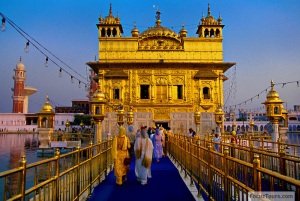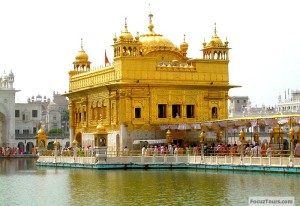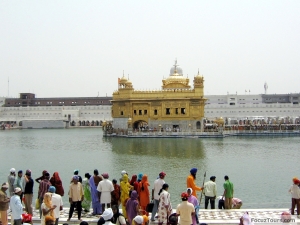Five Holy Sarovars in Amritsar
Numerous hallowed Sikh hallowed places might be discovered in the Sikh sacred city of Amritsar. Of specific criticalness are the five sacred pools in this city. These are called sarovars and it is the act of a few Sikhs to have a plunge in every one of the five of these sacred pools. The custom, separated from being great practice, familiarizes unified with the criticalness of these five destinations.
These five holy Sarovars are:
The name is currently utilized increasingly to allude to the city rather than the sarovar
It is home to the Sri Harmandir Sahib (alluded as the Golden Temple to western media), the otherworldly and social focal point of the Sikh religion. This significant Sikh holy place draws in a bigger number of guests than the Taj Mahal with more than 100,000 guests on week days alone and is the most obvious terminus for Non-inhabitant Indians (NRI) in the entire of India.
The city boasts of being the main centre of Sikhs’ cultural, religious and political history, it also houses the Sikh temporal and political authority, Akal Takht as well as the Sikh Parliament. Amritsar is also known for the tragical incidents of Jallianwala Bagh Massacre in 1919 under British Rule and Operation Bluestar in 1984 under the dictatorship of late Prime Minister of India, Indira Gandhi in which thousands of innocent Sikhs lost their lives. The main commercial activities include tourism, carpets and fabrics, farm produce, handicrafts, service trades and light engineering. The city is known for its rich cuisine and culture. Amritsar is also home to Central Khalsa Orphanage, which was once a home to Shaheed Udham Singh, a prominent figure in the Indian independence movement.
Gurdwara Santokhsar Sahib is an historical sikh shrine, situated at distance of 700 Meters from Sri Harimandir Sahib. This is one of the five historical sarovers constructed by Guru Arjun Dev.
Kaulsar Sarovar
This is the Sarovar or pool next to the Gurdwara Mata Kaulan near Gurdwara Baba Atal in Amritsar, Punjab next to the main Darbar Sahib at Harmandar Sahib. It is named after a holy lady who was raised as a Muslim called Bibi Kaulan, the adopted daughter of the Qazi of Lahore.
Bibeksar (built 1628) This sarovar is located to south/south-east of the most important landmark for the Sikhs, Sri Harimandir Sahib in the city of Amritsar. Gurdwara Bibeksar Sahib is situated on the banks of the Bibeksar Sarovar.
Gurdwara Ramsar stands alongside the Ramsar sarovar, the smallest of Amritsar’s five holy sarovars. Located near Chativind Gate, on the south-eastern side of the walled city of Amritsar, the present Gurdwara Ramsar is a small marble-lined hall topped by a gilded, fluted lotus dome.
Culture & Wildlife Sanctuaries of Punjab
The culture of Punjab has its own particular special aroma. It is unmatched. The fragrance of this fruitful area is such in which the warmth of you-are-my own particular is natural. All neighborhoods hold pride in their customs and the Punjabis whose receptiveness has gotten proverbial likewise hold their special convention of neighborliness high in their estimation and also in their qualities of life. A visitor in Punjab is acknowledged as an agent sent by God. The Golden Temple or Sri Harmandir Sahib was started by Guru Ramdaas Ji.
Friendliness advertises fellowship and holds an unique essentialness for carrying individuals closer; adore and consideration stream out of it. In Punjab they say that the more you cherish the more it duplicates and you get back numerous increasingly times the graciousness that you give.
The land of Punjab, which is portrayed as the place that is known for Gurus, temples like Sri Harmandir Sahib, Pirs and the warriors, as a matter of trust has confidence in gaining genuine living through hard labour and in imparting the soil grown foods of this labour to others, without needing any returns. Neighborliness is a living part of Punjabi society, which is demonstrated even to the transient feathered creatures that visit here.
Hospitality ties people together in bonds of adoration; it expands rings of friendship Culture & Heritage -Punjab, India and makes the air glow with human warmth. Punjabis have demonstrated this in all corners of the planet in obviously outsider terrains and as a result of these qualities they have been eagerly acknowledged as of service, capable citizens of the world, warm neighbors and exceptional companions. The temple Sri Harmandir Sahib is committed to the Hindu goddess Durga.
Wildlife is an important component of our environment. The Wildlife Preservation Wing, Punjab is responsible for the protection, conservation and management of wildlife both in nature as well as in captivity. The protection works include detection of wildlife offences and their prosecution in the courts and enforcement of Wildlife (Protection) Act, 1972. The wildlife conservation and management activities involve rehabilitation of various species of wildlife to their natural habitat, management of Zoos and Mini Zoos (Deer Parks), protection of rare and threatened species of birds and animal’s along with management and development of protected areas in the state. There are 12 wildlife sanctuaries duly notified in the State. The total area under these sanctuaries is 32,370.64 ha.
Some of them are:
Bir Motibagh
Bir Moti Bagh Wildlife Sanctuary was one of several prized hunting reserves of Patiala’s royal house. The sanctuary covers an area of approximately 654 hectares, which includes a deer park.
Chhatbir Zoo
The Mahendra Chaudhary Zoological Park was created out of the Chhatbir Protected Forest in 1977. Named after the governor of Punjab who envisioned it, the Park continues to support conservation of endangered and rare species of wildlife through captive breeding, as well as, encouraging research and awareness on wildlife.
Ropar Wetland
This is a man-made freshwater wetland covering 1,365 hectares. Also called the Ropar Lake, the wetland developed consequent to the construction of a regulator on the Sutlej River.
Bir Bhunerheri Wildlife Sanctuary
A popular attraction, Bir Bhunerheri Wildlife Sanctuary, was once the hunting reserve of the erstwhile rulers of Patiala. Declared a wildlife sanctuary in 1972, it covers over 661 hectares and is divided into two by a road running through it.
Amritsar Travel Guide
 Amritsar is a sacred city in the state of Punjab, India. The name of the city infers from the name of the pool around the Sri Harmandir Sahib and implies “heavenly pool of nectar” (Amrit: remedy; Sar: (short for sarovar) lake). It is the profound and social middle of the Sikh religion, and they are legitimately exceptionally glad for the city and their extremely excellent and exceptional Gurdwara (place of love). The Golden Temple or Sri Harmandir Sahib was started by Guru Ramdaas Ji, the fourth Sikh Guru, and finished in 1601 by his successor Guru Arjan Dev Ji. It is presently a major journey and tourism focus.
Amritsar is a sacred city in the state of Punjab, India. The name of the city infers from the name of the pool around the Sri Harmandir Sahib and implies “heavenly pool of nectar” (Amrit: remedy; Sar: (short for sarovar) lake). It is the profound and social middle of the Sikh religion, and they are legitimately exceptionally glad for the city and their extremely excellent and exceptional Gurdwara (place of love). The Golden Temple or Sri Harmandir Sahib was started by Guru Ramdaas Ji, the fourth Sikh Guru, and finished in 1601 by his successor Guru Arjan Dev Ji. It is presently a major journey and tourism focus.
Raja Sansi International Airport is in the vicinity of 15 km and a 20-30 minutes drive from the downtown area. It’s one of the cutting edge runways in India and truly sufficient if not precisely electrifying. Generally flights are to Delhi, a hour away, yet there are an expanding number of worldwide associations: Jet travels to London, Air India travels to Toronto by means of London and Air Slovakia travels to Bergamo, Barcelona and Birmingham by means of Bratislava. There are additionally astonishing amounts of flights to Central Asia (eg. Turkmenistan, Kazakhstan)
Amritsar (IR station code: ASR) is an important railway station and is well connected to major cities in India through daily trains. Trains can be booked online at the train station or, most conveniently, at the small booking office in the Golden Temple Complex.It’s advisable to book your return train ticket as soon as you arrive in Amritsar, or before if you know the exact date, as trains are often heavily booked.
Long-distance taxis are available from most places. It takes around 6-7 hours from New Delhi via NH-1.
Amritsar is well-connected by bus to most major cities and the northern areas within a days drive. Pathankot is about 2.5 hours away, and there are daily direct buses to New Delhi, Jammu, Katra, Chandigarh, Dharamsala (once daily, 6 hours), etc. You can find Volvo buses from Chandigarh , Delhi and Katra to Amritsar.
From Pakistan
If coming from Wagah at the Pakistani border, take a cycle-rickshaw (Rs 15, 3km) to the Attari station, where you can catch a local bus to Amritsar (Rs 15, 25 km).
Taxis also use this route and charge around Rs 200 for the entire vehicle.
Get around
An auto-rickshaw from the train station to the temple should cost around Rs 40, while a cycle-rickshaw will run about Rs 20-25.
There is a free bus service from the train station to the golden temple or our famous Sri Harmandir Sahib temple.
Tourist Places in Amritsar
Amritsar is a city with a splendid blend of tradition and culture. With important religious centers and historical sites, the city reveals a magnificent past and a promising future. The city is known as the Jewel of Punjab. There are several heritage and religious tourist places in Amritsar. The famous one is Sri Harmandir Sahib. Some of other major attractions are as follows:
Places to See in Amritsar
Popularly accepted to have been laid in 1574, the city of Amritsar is a standout amongst the most voyaged traveler destinations in India because of the being of some religious locales. It truly offers a host touring choices that are acknowledged as a percentage of the best vacation spots in Amritsar.
Despite the fact that there are various Sikh places of worship in and around Amritsar, Golden Temple also known as Sri Harmandir Sahib is the grandest of all tourist destinations in Amritsar. The sanctuary houses the blessed script of the Guru Granth Sahib and draws its name from the gold-laden vault upon a marble base. Inside lies the blessed lake. Do spread your head with a cloth or a scarf before entering the Gurudwara. The picture depicts the night sewa at Sri Harmandir Sahib.
The various tourist attractions in Amritsar are discussed as follows:
In 1919, the British Police fired randomly on a peaceful assembly of people gathered in demand of freedom, which killed hundreds of men, women and children on the spot. The bullet marks on the boundary walls bring alive the agonizing tale of cruelty of colonial rule.
This temple Sri Harmandir Sahib is committed to the Hindu goddess Durga. Then again, it additionally offers petitions to God to divinities of Lakshmi and Narayana.
Actually demarcating the Indo-Pakistan outskirt, Wagah is only 28 km from the fundamental town of Amritsar. The ‘change of guards ceremony’ at dusk draws an exceptional numerous onlookers.
 Maharaja Ranjit Singh Panoramio
Maharaja Ranjit Singh Panoramio
Maharaja Ranjit Singh, all the more prevalently reputed to be ‘the Lion of Punjab’ was an incredible child of Punjab as well as around the few heading figures of the history of that period. The deeds of Maharaja Ranjit Singh will stay as lasting checks in the records of sikh history.
Maharaja Ranjit Singh Panorama is a perpetual image based documentation of Maharaja Ranjit Singh and it has been conceptualized and set up by National Council of Science Museums, a self-governing conglomeration of the Ministry of Culture, Government of India. The sprawling 4.5 sections of land of area in the significant Rambagh Heritage Garden at the heart of the blessed city of Amritsar has been made accessible for improving the display by the Government of Punjab, though the whole cost of setting up of the scene has been borne by the Government of India. A tastefully composed tall round and hollow building encompassed with green cultivate close Summer Palace of Maharaja in the Rambagh Heritage Garden is currently a point of interest in the city of Amritsar.
The primary fascination of the landscape is a tremendous 12 meters tall and 100 meters in length surrounding painting portraying six major fight campaigns of the Maharaja. The fight endeavors delineated in the painting are supplemented by expansive round forefront diorama showing various mannequins of noticeable warriors, officers, creatures, weapons etc. A uniquely composed inventive light of the huge painting and the forefront diorama, supported by battle-field sound effects at the background enhance the level of the experience of the viewers.
The Maharaja’s Grand Durbar at Lahore has been reproduced in the scene corridor through a vast three-dimensional dioramic presentation where Maharaja is seen with his bosses, nobles and likewise the poor and destitute. The different points of interest in the vibrant life compass of the Maharaja have been displayed through eight more modest dioramas in the ground floor lobbies. Some other critical tales connected with Maharaja, which have deified him, are additionally displayed in the scene building through wall paintings, portrays and canvas sketches. The intelligent touch screen media booths set in the scene furnish definite informative data of the subject to the guests.



















































